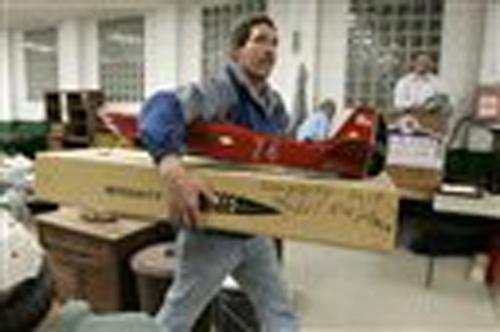Popularity of Web auctions helps fuel growth in live auction industry

Dave Kauffman, who traveled 220 miles from Marysville, Ohio, in search of vintage, remote-control model airplanes takes one of five loads of purchases to his car during an auction Nov. 2, 2007 in Waynesburg, Pa. Kauffman, 49, has trolled the Internet for Gene J. Puskar, The Associated Press
Nov 26, 2007
Last updated on May 12, 2016 at 06:55 p.m.
WAYNESBURG, Pa. – His chanting is rhythmic and rapid, a staccato string of numbers that quickly grows hypnotic as auctioneer Kevin Teets scans the audience, eyes darting between buyers on opposite sides of the room.
Perched in the front row is Dave Kauffman, who has come 220 miles from Marysville, Ohio, in search of vintage, remote-control model airplanes and accessories.
Within hours, Kauffman has so many planes and parts, to be resold at flea markets and online, that it takes five trips to load his hatchback at the Greene County Fairgrounds.
“I can tell from the first sale if it’s going to be a good night,” he said. “Tonight was a very good night.”
Get The Daily Illini in your inbox!
Although auctioneers initially considered the Internet a threat, its growth and development of searchable Web sites like AuctionZip have contributed to a boom in the live-auction industry, with one-time rivals forming partnerships that produce bigger audiences for sellers, often by simulcasting live auctions on the Web.
Buyers emboldened by success on eBay and other sites are seeking live sales in search of lower prices – and the thrill of competing in person.
Sales of goods and services at live auctions totaled $257 billion in 2006, a surge of 7 percent over 2005.
A study for the Kansas-based National Auctioneers Association found residential real estate auctions have grown 39 percent since 2003, agricultural real estate grew 33 percent, and sales of commercial and industrial property surged 27 percent. Car auctions increased by 10.5 percent and charity auctions rose 16.5 percent.
“I don’t know where the auction industry would be without the Internet,” said Teets, of Fairmont, W.Va. He turned professional three years ago and made the top 12 at the 2007 bid-calling world championships in San Diego.
“The Internet has educated the buyers. It’s educated the sellers. It’s opened a lot of these small sales up,” said Teets, 31, who works for Joe R. Pyle Auctions of Mount Morris, Pa.
Earlier this year, the 6,000-member National Auctioneers Association teamed up with Gemstar-TV Guide International to launch Auction Network, which produces Webcasts of auctions.
“The Internet has been the greatest thing that ever happened to the auction industry,” said NAA president Tommy Williams, an Oklahoma real estate auctioneer. “It made us reinvent ourselves.”
Auctioneers were slow to embrace the Internet because it was considered competition, said Ina Steiner of Natick, Mass., editor of AuctionBytes, a trade publication for online merchants.
But now, even rural residents often have sufficient Web service to compete and sellers realize that customers have choices far beyond eBay. There are specialty sites like Bid4Assets for real estate and IronPlanet for construction equipment.
“General consumers, they go to sites like eBay,” Steiner said. “But they might go to Google. Google’s the great equalizer. If an auction site is savvy and has a listing optimized for Google, people can find them.”
The intersection of live and virtual auctions promises nearly limitless opportunity, and a few companies have already found niches by pairing traditional auction houses with the online world.
Julian Ellison moved from London to New York in 1999 to launch LiveAuctioneers, a Webcasting project. In 2002, he persuaded San Francisco-based eBay to partner on live Web auctions.
At the time, eBay had 25 million users; today it boasts 275 million. Ellison has ventures with 638 auction houses worldwide and annual sales approaching $100 million.
“A lot of our auction houses that we started doing business with were on their knees,” he said. “Some have said to me: ‘You guys have absolutely saved our bacon.'”
The changing world also creates opportunity for individuals, and the NAA is beginning to see more women and minorities entering the profession. The world champion bid-caller, former real estate investor Denise Shearin of Brandywine, Md., is the first black auctioneer to hold the title.
Shearin, who went pro in March 2006, was initially captivated by the chanting but quickly learned there’s more to the business, requiring constant re-education about values, intensive marketing efforts and sophisticated people skills.
“Like so many other businesses, you get out of it what you put into it,” she said. “If you really enjoy it, 50, 60 and 70 hours a week really do go by very quickly and fairly easily.”





